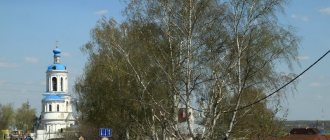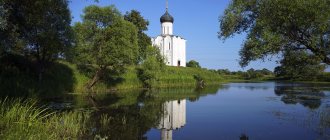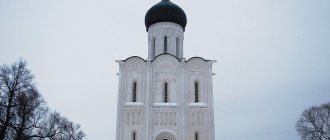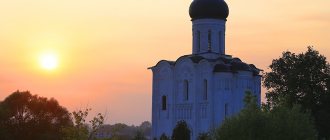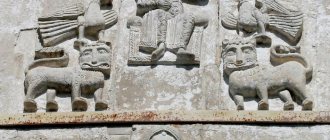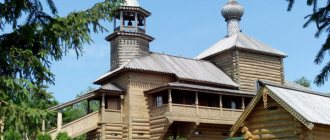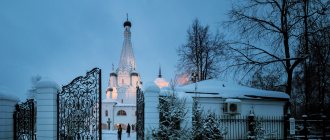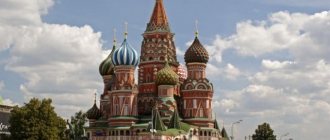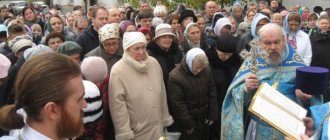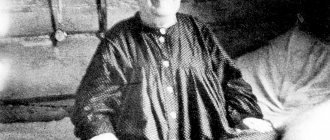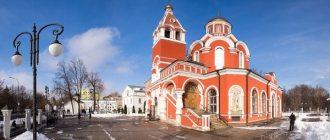TO THE PAGE “SCIENTIFIC WORKS”
TO THE MAIN PAGE OF THE SITE
S.V. Zagraevsky
New studies of architectural monuments
Vladimir-Suzdal Museum-Reserve
Preface
CHAPTER 1: Organization of mining and processing of white stone in Ancient Rus'
Chapter 2: The beginning of the “Russian novel”: Yuri Dolgoruky or Andrei Bogolyubsky?
CHAPTER 3: about the hypothetical “interim” construction of the Cathedral of the Nativity of the Virgin Mary in Suzdal in 1148 and the original appearance of the Suzdal temple of 1222–1225
CHAPTER 4: Issues of dating and status of the Church of Boris and Gleb in Kideksha
CHAPTER 5: issues of architectural history and reconstruction of the Vladimir Assumption Cathedral of Andrei Bogolyubsky
CHAPTER 6: to clarify the reconstruction of the Golden Gate in Vladimir
CHAPTER 7: Bogolyubovsky architectural ensemble: issues of history and reconstruction
CHAPTER 8: On the issue of reconstruction and dating of the Church of the Intercession on the Nerl
Chapter 9: Issues of reconstruction of the Vladimir Assumption Cathedral by Vsevolod the Big Nest
CHAPTER 10: Questions of the original appearance and dating of the Demetrius Cathedral in Vladimir
NOTES
CHAPTER 8
On the issue of reconstruction and dating
Church of the Intercession on the Nerl
1. Question about the original appearance of the Church of the Intercession
The Church of the Intercession is located on water meadows near the confluence of the Nerl and Klyazma rivers (the general view of the temple is shown in Fig. 71 and 72). In the 12th century, the Klyazma flowed somewhat to the north, and the church was located practically on the river “spit”, forming a crossroads of the most important water trade routes1.
Rice. 71. Church of the Intercession on the Nerl. View from the water meadows.
Rice. 72. Church of the Intercession on the Nerl. Northern façade.
The veil on the Nerl is a four-pillar, three-apse, single-domed temple, built of white stone of the highest quality (the masonry is very uniform, there is practically no yellowish tint in it, the porosity of the blocks is very low - in a word, this quality of masonry is not found in any of the ancient Russian white stone churches). To lighten the vaults, tuff-like limestone was used2.
The temple stands on a unique foundation consisting of eight rows of high-quality smooth-cut white stone (in total about 4 m deep), based on a rubble base common to the architecture of North-Eastern Rus', almost square in cross-section (about 2 m deep).
From the 12th century temple, the main volume has been preserved to this day without significant distortion - a small, almost square in plan (about 10 x 10 m excluding apses, the side of the dome square is about 3.2 m) quadrangle and dome.
The divisions of the northern and southern walls of the temple are asymmetrical, the eastern spindles are very narrow. However, the sum of the protrusion of the side apses and the width of the eastern sections of the walls is almost equal to the width of the middle sections of the walls, and thanks to this, the composition of the temple looks balanced when viewed from any side.
The ratio of the width of the western facade of the Church of the Intercession on the Nerl to its height is approximately 0.85 (for comparison: in the Vladimir Assumption Cathedral of Andrei Bogolyubsky and Demetrius Cathedral this ratio is close to one). The arcature-columnar belt with a curb is located slightly above the choir level; its top divides the façade into two almost equal parts. Such proportions create an exceptionally “slender” silhouette of the temple.
The drum of the Church of the Intercession is also strongly elongated upward - the ratio of its diameter to height is 0.8 (in the Demetrius Cathedral - approximately 1).
Multi-broken pilasters with half-columns on the outer side of the walls of the Church of the Intercession on the Nerl correspond to the internal blades. Their total thickness is approximately one and a half times wider than the walls, and this creates a very clear structural “drawing” of the temple.
The columns of the arcature-columnar belt, tapering upward, are located very “closely” (much closer to each other than on the Assumption Cathedral), and the arches are strongly compressed and have a horseshoe shape. This architectural solution also emphasizes the general “upward direction of the temple”
Above the arcature-columnar belt, above the low tide, new profiles begin - zakomara and windows. On the apses, an arcature-columnar belt with a curb is located on top; some columns of the belt are replaced by half-columns descending to the base, which creates a solid and “vertically oriented” picture of the apses’ decor.
In general, the impression of “the upward direction of the proportions of the temple” is so great that the walls of the Church of the Intercession, with their verticality, seem to taper upward.
And in the interior, the cross-shaped pillars actually taper towards the top, which, given the small size of the temple, creates an additional feeling of “height” in the interior.
In general, the temple gives the impression of not only being “high-rise”, but also very “ornate”, despite the relatively modest (in comparison, for example, with St. Demetrius Cathedral) decor of a zoo-anthropomorphic type. In the tympanums of the zakomari there are images of King David, lions, doves, griffins with lambs and women’s masks, in the bases of the columns of the arcature-columnar belt there are images of masks, animals and monsters. The drum is decorated with arcature-columnar and crenate belts. In the interior, paired lions are placed at the heels of the girth arches.
The perspective portals of the Church of the Intercession are decorated with foliate capitals and carved semicircular archivolts. The Attic profile of the plinth is similar to the profile of the plinth of the Church of the Nativity of the Virgin Mary in Bogolyubovo.
Archaeological research conducted by N.N. Voronin in the 1950s3 showed that the temple had galleries standing on foundations that were as unique as those of the temple, although of somewhat less depth4 (Fig. 73). The presence of galleries is proven by the discovery of their foundations and, probably, a profiled white stone block belonging to them5 (Fig. 74).
Rice. 73. Section and plan of the Church of the Intercession on the Nerl with the foundations of the temple and hypothetical open galleries. Reconstruction by N.N. Voronin.
Rice. 74. Profiled white stone block, discovered by excavations by N.N. Voronin.
Later attempts to question this discovery of N.N. Voronin do not look convincing. Thus, P.N.Arkatov6 and K.N.Afanasyev7 believed that additional foundation walls were erected in order to strengthen the artificial hill built around the temple.
P.A. Rappoport, criticizing the position of P.N. Arkatov and K.N. Afanasyev, cited numerous examples of galleries in the architecture of Suzdal and other ancient Russian principalities8. However, P.A. Rappoport’s counterargument cannot be called exhaustive, since all his examples related to closed porch galleries, and N.N. Voronin believed that the galleries were open9 (for N.N. Voronin’s reconstruction, see Fig. 73 and 75 ). Here are some additional arguments in favor of having galleries:
– P.N. Arkatov and K.N. Afanasyev ignored the above archaeological find, rightly identified by N.N. Voronin as a fragment of galleries;
- it would make no sense to strengthen the hill exclusively with powerful retaining walls made of smooth-cut stone on rubble foundations located so close to the temple, since it would still be eroded from the outside of these walls. Then it would make sense to “move” these walls to the edges of the hill, which would make them significantly lower and would save a lot of valuable smooth-cut stone;
- the artificial hill was reinforced more reliably than with retaining walls - with a solid white stone pavement10;
Rice. 75. View of the Church of the Intercession on the Nerl with hypothetical open galleries. Reconstruction by N.N. Voronin.
Thus, we confirm the fact that there are galleries at the Church of the Intercession. But the following questions remain open:
– whether the galleries were erected simultaneously with the temple or later;
– if later, then by how much;
– whether the galleries were open or closed.
First of all, we note that, according to the archaeological research of N.N. Voronin11, the rubble foundation of the Church of the Intercession on the Nerl was at the level of the ground surface in the mid-12th century, and the rubble foundation of the galleries was about half a meter higher (Fig. 73). Then, as the walls were built from smooth-cut stone, the interior space of the building, right up to the walls of the galleries, was gradually (precisely gradually, and excavations convincingly showed this) filled with soil. Outside, the already mentioned artificial hill also grew (without traces of gradual filling), which covered these walls (the walls of the galleries were completely, and the hill did not reach the base of the temple by about two rows of masonry).
Based on the fact that the layers of construction debris inside the temple were identical to the layers of construction debris between the foundation walls of the temple and galleries12, we are obliged, following N.N. Voronin, to assume the simultaneous construction of these foundation walls (but not the above-ground parts of the temple and galleries, as we will soon see ).
The question of why the rubble foundation of the galleries was laid half a meter above the rubble foundation of the temple, and the top of the smooth-hewn walls of the gallery foundation was located almost a meter below the level of the temple base, N.N. Voronin did not investigate.
The question of the unjustifiably “wasteful” use of smooth-cut stone for foundations also remained open. N.N. Voronin explained this by saying that in this way the stability of the upper parts of the building was better ensured. This version looks somewhat strained, since stability would be ensured by both ordinary rubble foundations and foundations made of rough-processed stone.
We have already said that archaeological excavations discovered columns that, in all likelihood, belonged to galleries13. Consequently, the galleries had above-ground parts that stood on the foundation walls. But then two more questions arise:
– why are there no traces of adjacent gallery ceilings on the walls of the temple, including the arched-columnar belt?
– why did the galleries close the completely completed (and very labor-intensive in execution) arcature-columnar belt?
To the first question, N.N. Voronin gave an absolutely comprehensive answer: the ceilings were wooden, and only a few transverse beams could be adjacent to the walls of the temple along their entire length, the nests of which were later laid (in the 1970s, these nests were discovered by S.M. Novakovskaya-Buchman14).
Answering the second question, N.N. Voronin wrote that “this was the system of work of the Vladimir masters - completely illogical, from our modern point of view”15. P.A. Rappoport supported the point of view of N.N. Voronin16. In other words, N.N. Voronin and P.A. Rappoport believed that the ancient Russian masters deliberately went to “Sisyphean labor”, without having any reason for this, except for “peculiar logic”. As the main example of such a “Sisyphean labor,” researchers cited the arched-columnar belt of the northern wall of the Church of the Nativity of the Virgin Mary in Bogolyubovo17 (see Chapter 7, Fig. 45), covered with an arch and a passage.
However, in ch. 7 we showed that in the work of Bogolyubov’s masters there was no “peculiar logic,” much less “Sisyphean labor.” At the time of construction of the Church of the Nativity of the Virgin Mary, the craftsmen did not yet have a clear opinion about what the entrance to the choir would be like and how the church would be connected to the palace complex - it could not be a bulky stone passage over the arch, but a light wooden bridge or even a simple wooden staircase . Accordingly, the actions of the craftsmen, who completely laid out the arcature-columnar belt of the Church of the Nativity of the Virgin, seem quite logical from a modern point of view.
We can say the same about the galleries of the Church of the Intercession on the Nerl. Understanding that they could have been added to the temple a little later (for example, a few years after construction) allows us to believe that the logic of the ancient Russian craftsmen in this matter did not differ from the modern one: when hewing out the belt, they still did not know whether there would be any temple galleries and stair towers. The version of the later construction of the galleries is also supported by the ornament on the block with a semi-column discovered by excavations (see Fig. 74): this ornament has no parallels in the decoration of the Church of the Intercession on the Nerl.
But, as we saw above, the foundation walls of the galleries were erected simultaneously with the foundation walls of the Church of the Intercession. Is there a contradiction here?
There is no contradiction, and we can show this by trying to reconstruct the stages of construction of the Church of the Intercession and galleries, taking into account all the questions that we raised:
- why the rubble foundation of the galleries was laid half a meter higher than the rubble foundation of the temple;
– why the top of the smooth-hewn walls of the galleries’ foundation is located almost a meter below the level of the temple’s base;
– why there was an unjustifiably “wasteful” use of smooth-cut stone for foundations;
– why the fully completed arcature-columnar belt was closed with galleries.
Apparently, the point was that, as often happened with buildings that enjoyed the close attention of rulers (and the Church of the Intercession not only “designed” a particularly important crossroads of trade routes, but was probably visible from the windows of Prince Andrei’s palace in Bogolyubovo) , the construction plan changed several times during implementation. Most likely, approximately the following stages took place:
1. At first, the temple was conceived by its architect and craftsmen (in the future we will generally call them builders) without galleries, standing on a high smooth-hewn podium.
2. Having laid a rubble foundation and raised the smooth-hewn walls of the podium to about one and a half meters (the level of the first backfill of white stone building chips determined during excavations19), the builders decided to surround the temple with galleries standing on a similar podium.
3. The builders laid the rubble foundations of the galleries (half a meter higher, since the level of the day surface had managed to increase during the previous construction) and began to parallelly build the walls of the temple podiums and galleries. Both walls were built from smooth-cut stone, including the inner one (for the temple), since the stone for it had already been prepared in advance anyway.
4. Having completed both walls almost to the top, the builders abandoned the construction of galleries. Perhaps they realized that the temple with the galleries was losing the “upward direction” to which, as we showed at the beginning of this chapter, great importance was attached.
5. In this situation, it was necessary to demolish the smooth-hewn walls of the podium of the galleries, since they covered the podium of the temple. But nevertheless, the builders chose not to demolish them, but to build an artificial hill around them, since during construction they should have realized that the smooth-hewn podium of the temple was a very unreliable structure that could be washed away during river floods. The “force” of filling the hill is confirmed by the fact that it still turned out to be not high enough, and during floods the water often reached the base of the church.
6. The construction of the walls of the podium of the galleries was accordingly stopped, and the podium of the temple was raised to the height of two more blocks of stone20.
7. On this podium the Church of the Intercession on the Nerl was built in the form in which it has survived to this day. In this regard, we are forced to admit that the modern appearance of the temple quite adequately reflects, if not the original plan of the architect (probably, the temple was conceived to stand on a smooth-hewn podium), then the basic stage of its construction implementation.
8. During the construction of the temple, the issue of access to the choir had not yet been resolved (since the galleries were abandoned), so the builders completed the arcature-columnar belt completely.
9. Then a certain staircase and (or) staircase tower was added to the temple to enter the choir. Perhaps these extensions were made of wood.
10. Later (perhaps several years later, or even after the death of Andrei Bogolyubsky), galleries were erected on the previously built foundation walls, fragments of which were discovered by excavations21.
In connection with the above, we may wonder what these galleries were like. N.N. Voronin believed that they were open, since they “best harmonized with the structure of the forms of the temple itself”22 and should have emphasized the “ceremonial” status of the Church of the Intercession. But there are serious doubts about this position:
– firstly, any of our statements about the “best harmony” regarding Ancient Rus' are inevitably subjective;
– secondly, the powerful foundation walls of the open galleries would actually be a strip foundation, despite the fact that the temple itself does not have a strip foundation;
– thirdly, we do not know any precedents for open galleries in Ancient Russia23;
– fourthly, N.N. Voronin’s attempts to identify a white stone block with a semi-column and ornament that he found during excavations (see Fig. 74) as a fragment of a pillar of open galleries forced the researcher to give the reconstructed pillars of hypothetical galleries an extremely complex and unprecedented appearance in ancient Russian and world architecture form24 (Fig. 76). It is much more likely that the indicated block belonged to the corner of the walls of the closed galleries.
Rice. 76. A pillar of hypothetical open galleries. Reconstruction by N.N. Voronin.
Thus, we have the right to believe that the galleries were closed, i.e. had the character of a porch25. This is quite understandable for the purposes of expanding and insulating the temple, increasing its area, constructing aisles and utility rooms (a similar situation occurred in many ancient Russian churches). Consequently, we do not have the right to accept the reconstruction of N.N. Voronin (see Fig. 73 and 75) for any of the intermediate stages in the formation of the appearance of the Church of the Intercession.
N.N. Voronin reasonably associated the disappearance of the galleries with the construction of a new porch at the end of the 17th century26.
Where the three-dimensional sculptures of lions were located, discovered by the excavations of N.A. Artleben (Fig. 7727), we can only guess. They could be located above the hypothetical staircase to the temple from the pier, as suggested by B.A. Ognev28, and directly at the entrance to the temple, like many Romanesque cathedrals.
Rice. 77. Carved stones from N.A. Artleben’s excavations near the Church of the Intercession on the Nerl.
Based on all of the above, we believe that the modern appearance of the Church of the Intercession on the Nerl as a whole (with the exception of the shape of the dome - see Chapter 10) corresponds to the original.
Closed galleries (parvises) were added to the temple several years (perhaps even decades) after its construction.
2. Dating of the Church of the Intercession
Let's move on to the question of dating the Church of the Intercession on the Nerl.
Many researchers (including V.I. Dobrokhotov29, N.N. Voronin30 and P.A. Rappoport31) dated the temple based on the Life of Andrei Bogolyubsky, written in connection with the canonization of the prince in 1701. Here is the message from the Life:
“That same summer (1165) his first son, Izyaslav Andreevich, went to the Lord and was laid to rest in the cathedral church of the Assumption of the Blessed Virgin Mary. This same Grand Duke Andrei, although he was overcome by sadness about his deceased son, and grieved, was also more encouraged to do godly deeds; for the Bogolyubov monastery, as if there is one field, on the Klyazma River in a meadow, began to build a church in the name of the Most Holy Theotokos of Her Venerable Intercession, at the mouth of the Nerl River, from the stones collected and exported from the Bolgars for two years for the construction in Vladimir of the Cathedral of the Dormition of the Most Holy Theotokos Church and other tenths parts that, by his command, were laid aside in that place, and, with the help of the Most Holy Mother of God, completed this church in one summer and made a monastery for the monastics with it”32.
V.I. Dobrokhotov, based on this message from the Life, dated the Church of the Intercession to 1166, since Izyaslav died in the fall of 116533.
P.A. Rappoport believed that the construction of the temple began immediately after the death of Izyaslav (already in 1165) and ended in 116734. But there was an internal contradiction in the researcher’s position, since the temple, according to the message of the Life of Andrei Bogolyubsky accepted by P.A. Rappoport, was built “in one summer.”
N.N. Voronin took a not entirely clear position regarding the dating of the temple. In his opinion, the Church of the Intercession was “the most perfect monument among the buildings of Prince Andrei, as if completing their galaxy”35, but at the same time, in the corresponding section of his major work “Architecture of North-Eastern Rus' of the XII-XV centuries” he did not propose no dating of the temple36. Only after many pages37 an unfounded date appears for the first time - 1165. Subsequently, the researcher repeatedly mentioned this year as the time of completion of the stone construction of Bogolyubsky38.
But Izyaslav Andreevich died in the fall of 1165, and during the winter the Church of the Intercession could not be built. Why N.N. Voronin, recognizing the accuracy of the Life’s message that the temple was built in memory of Izyaslav39, accepted 1165 as the date, we do not know. Perhaps the researcher believed that the Church of the Intercession was built after the Church of the Savior in Vladimir, which, in his opinion (albeit expressed very indirectly40), was completed in 1164. However, this motivation is also doubtful, since N.N. Voronin left uncertain the date of the Church of the Nativity of the Virgin Mary in Bogolyubovo41.
Thus, we are forced to state that the dating of the Church of the Intercession to 1165 is arbitrary and unsatisfactory
(unfortunately, it was 1165 that was fixed in most of the scientific, educational and popular literature - both as the date of the Church of the Intercession on the Nerl, and as the time of the end of the temple construction of Andrei Bogolyubsky42). If we are based on the Life of Andrei Bogolyubsky, then the dating of V.I. Dobrokhotov seems most satisfactory - 1166.
However, there are a number of reasons why we cannot accept the message of the Life as the basis for dating the Church of the Intercession.
Firstly, it is still very late (the beginning of the 18th century), and even if there were no obvious contradictions in it, it would be possible to accept it for dating only in the absence of other dating information (which, as we will soon see, we have There is).
Secondly, there are other lists of the Life of Andrei, besides the one published by V.I. Dobrokhotov, and they say nothing at all about the construction of the Church of the Intercession43.
Thirdly, in the indicated message of the Life there are a number of insoluble internal contradictions:
– it is unclear when Andrei managed to start “collecting” and exporting stones from Volga Bulgaria for the construction of the Vladimir Assumption Cathedral, if his campaign against Bolgar took place in 1164, and the construction of the cathedral began in 1158;
- even if we assume that the prince began to “collect” stones in Bulgaria for the Assumption Cathedral earlier than his campaign, then he could not have done this in 1156 - and according to the Life he collected and exported stones “for two years”;
– it is not clear how it was possible to “collect” the stones - they did not lie on the ground, their extraction and processing was a very difficult task (see Chapter 1);
– the results of micropaleontological studies44 conducted in the 1950s–1960s showed that the stone of the Church of the Intercession on the Nerl belonged to the Myachkovo horizon of coal deposits, i.e. this stone was mined near Moscow. Let us also note that the stone from which the Church of the Intercession was built is distinguished by its exceptional whiteness (it is significantly whiter than the stone of any of the ancient Russian white-stone churches), while the Volga limestone mainly has a gray-brown tint;
– if the temple had been built in memory of Izyaslav, then it is more likely that it would have been dedicated to the namesake saint of Bogolyubsky’s son. But the church is dedicated to the Feast of the Intercession;
– The Life says that the stones were “deposited” at the site of the future construction of the Church of the Intercession during the construction of the Assumption Cathedral. It turns out that in 1158 Andrei already knew that in 1165 his son would pass away and he would build a temple in his memory.
All these insoluble contradictions do not allow us to base the dating of the Church of the Intercession on the message of the late Life of Andrei Bogolyubsky (note that N.A. Artleben, D.N. Berezhkov and N.P. Kondakov also did not trust the Life, dating the temple in a wide time interval from 1158 to 1190s45).
We are able to fairly confidently determine the date of the temple based on consistent reports from pre-Mongol chronicles, which were previously ignored by researchers for unknown reasons.
First of all, let us again recall the message of the “Short Chronicler of Vladimir”: “And then Andrei Yuryevich came from Kyiv and created the God-loving city and the scree, and erected two stone churches”46. The fact that here we are talking about the Church of the Nativity of the Virgin Mary in Bogolyubovo and the Intercession on the Nerl is confirmed by the message of the Novgorod First Chronicle: “And build her (the Virgin Mary - S.Z.) a temple on the Klyazma River, two stone churches in the name of the Holy Mother of God”47.
As we have already shown in Chap. 7, both chronicle messages clearly link the founding of the city of Bogolyubov and the construction of the churches of the Nativity of the Virgin Mary and the Intercession. The dates in these two chronicles are not given, but the date of foundation of Bogolyubov is clearly stated by the Novgorod IV Chronicle under 1158: “And the city was founded by the Bogolyubivoe”48.
Consequently, we are obliged to accept this year as the date of both the Church of the Nativity of the Virgin Mary (see Chapter 7) and the Church of the Intercession on the Nerl.
In ch. 7 we saw that this position is confirmed by the message of the Vladimir chronicler49 under the year 1158: “The same Prince Ondrei Bogolyubovnyi city of talus, erected one church, the stone Nativity of the Holy Mother of God on the Klyazma River, and another Church of the Intercession of the Holy Mother of God on the Nerl, and built a monastery”50.
It remains to consider the question of whether the Church of the Intercession could have been built during 1158.
We believe that the message from the Life of Andrei Bogolyubsky that the temple was built “in one summer” can be trusted in this case. All the above chronicle reports say that the Church of the Intercession in 1158 was precisely “erected” - and we showed in Chapter. 4 and 7 that in the weather chronicle the term "set" most often meant construction within one year, and that many temples of similar scale were actually erected during one construction season.
Consequently, we accept 1158 as the dating of the Church of the Intercession.
The galleries, as we saw above, could have been erected several years (if not decades) later. Thus, galleries were added to the Dmitrievsky Cathedral no less than 8 years after the completion of the temple (see Chapter 10).
N.N. Voronin called the Church of the Intercession on the Nerl “the best construction of Vladimir architects”51, “the most perfect monument in the series of buildings of Prince Andrei, as if completing their galaxy”52. But now we have the right to believe that after the Church of the Intercession (1158), the Assumption Cathedral in Rostov (1161–116253) and the Church of the Savior in Vladimir (1164 - see paragraph 3) were built with chronicle dates.
Therefore, without in any way detracting from the exceptional architectural and artistic merits of the Church of the Intercession, we will give it a slightly different characteristic: this is the most famous building of the architects of pre-Mongol North-Eastern Rus' (perhaps even more famous than the Assumption Cathedral in Vladimir), and many problems with which researchers of this monument encounter are associated with its world fame, which gives rise to many stereotypes.
3. Church of the Intercession on the Nerl as a possible prototype of the Church of the Savior in Vladimir; thoughts on the Vladimir courts of Yuri Dolgoruky and Andrei Bogolyubsky
The Church of the Transfiguration of the Savior was built by Andrei Bogolyubsky from white stone in the southwest of the “New City” of the Vladimir fortifications of 1158–1164 (see Fig. 45), not far from the Golden Gate.
After the fire of 1778, the white stone temple was destroyed, and in its place a new brick church was built, which currently exists (Fig. 78). The location of the old temple on the site of the new one was confirmed by excavations carried out under the leadership of N.N. Voronin in 195354. In the lower parts of the walls of the 18th century church, white stone was widely used in secondary use.
Rice. 78. Church of the Savior. General form.
It is important to note that the masters of the late 18th century stylized the church “antique”, without copying the old temple (like the builders of the cathedral of the Vladimir Nativity Monastery in the 1860s and the Staro-Nikolsky Cathedral in Mozhaisk in the 1840s), without building a new temple in contemporary style (like the builders of the Church of the Nativity of the Virgin Mary in Bogolyubovo in the mid-18th century and the Church of St. George in Vladimir in the 1780s), and combining features of pre-Mongol architecture and Baroque. The result of their work was a unique architectural monument that has no analogues in the architecture
of the 18th – 19th centuries
.
We currently know nothing about the plan, forms and dimensions of the Church of the Savior of the 12th century. Judging by the quadrangle of the Spasskaya Church of the 18th century and the general ideas about the architecture of the time of Andrei Bogolyubsky, the temple of the 12th century was four-pillared, single-domed and three-apsed.
The decor of the Church of the Savior of the 12th century is also unknown to us, with the exception that with a high degree of probability the temple should have had arched-columnar belts and perspective portals reproduced in the 18th century (Fig. 79).
Rice. 79. Church of the Savior. North wall.
To date, there is no architectural and archaeological data indicating that the Church of Andrei Bogolyubsky replaced the Plinthian Spassky Church from the time of Monomakh55.
The foundation of the Church of the Transfiguration of the Savior is dated, according to various chronicles, to 116056, 116257 and 116458. N.N. Voronin believed that the last date given in the Laurentian Chronicle was incorrect, since the chronicler, according to the researcher, “summed up” the founding of the temple and the emergence of the “Leontian heresy”59. For unknown reasons, N.N. Voronin ignored the first date60 and believed that the temple was founded in 1162 and completed in 116461.
However, as we have noted more than once in our research, the information from the few chronicle sources regarding the pre-Mongol time is so precious that we do not consider ourselves entitled to disavow, much less ignore, any of these dates. The discrepancy in chronicle dates in this case has a completely logical explanation: since the “foundation” was usually understood as a solemn service “on the foundation of the church”62, it can be assumed that the “zero cycle” of the construction of the temple was delayed, and this led to the fact that the service “on the foundation "was repeated several times: in 1160, 1162 and 116463. The last foundation was final, and after it, construction finally began, which lasted, as in most temples of this scale, one year (see paragraph 2).
Accordingly, we date the Church of the Savior to 1164 and can move on to the question of its status.
N.N. Voronin assumed that “the construction of a new white-stone temple next to the Church of St. George in the courtyard of Dolgoruky was connected with the organization of a new courtyard of Prince Andrei himself”64, i.e. in fact, the Spasskaya Church was the prince’s home church. This point of view today is stereotypical, and the most common name for the temple is “the Church of the Savior in the Vladimir courtyard of Andrei Bogolyubsky.”
However, for a number of reasons we cannot agree with this assumption.
Firstly, neither N.N. Voronin nor any other researchers gave any arguments in favor of the fact that Andrei Bogolyubsky’s Vladimir courtyard was near the Church of the Savior.
Secondly, the main residence of Prince Andrei was Bogolyubovo.
Thirdly, the Church of the Savior is located to the west of the center of Vladimir, and Bogolyubovo is to the east. If Andrei had a need to build some kind of “auxiliary” courtyard in Vladimir, then it could most likely be located on the Bogolyubov side (probably on the site of Vsevolod’s future courtyard, the Big Nest, mentioned in 1177 at the Demetrius Cathedral65.
Fourthly, the Church of the Savior is located almost on a straight line between the Golden (“front”) and Volga (main trade) gates of Vladimir (see Fig. 45).
Fifthly, the location of the Church of the Savior can be considered unique: it is not only located very close to the slope above the Klyazma (and thanks to this it was perfectly visible from the river), but also stands on a hill, significantly rising above the adjacent streets. This also emphasizes the importance of the temple, but excludes the presence of a nearby fortified courtyard, since there is too little space on this hill for a palace, outbuildings and fortifications (unlike, for example, the area around the Church of St. George - see below).
Sixthly, Andrei inherited the courtyard with the white stone St. George Church from his father, Dolgoruky. The fact of the presence of a fortified courtyard of Yuri Vladimirovich around the Church of St. George is confirmed by the following provisions66:
- Yuri, who reigned in the Suzdal land from the beginning of the 12th century, could hardly have not had his own court by the 1150s in one of the largest (if not the largest) city of the Suzdal land - Vladimir;
– the area around the Church of St. George is extremely advantageous from the point of view of natural protection: it was flanked on three sides by a cliff and two ravines, and the “floor” side is very short;
– in 1152, when the Church of St. George was built (for the rationale for its date, see Chapter 4), it was still outside the city fortifications, since the walls of the “New City” were built only in 1158–1164 (see Fig. 45 ). Consequently, there must have been separate fortifications around the church, and this could only have been the prince's court;
- the dedication of the church to the namesake saint of Dolgoruky - George - in itself cannot serve as evidence that the temple was a brownie, but in the light of the previous provisions, this should also be paid attention to.
Consequently, it is unlikely that Andrei Bogolyubsky had a need next to his
Vladimir courtyard (formerly Yuri’s courtyard) to build another courtyard - after all, Andrei’s main residence, as we just noted, was Bogolyubovo.
From all of the above, we can conclude that the Church of the Savior was not a house church, but a separate “ceremonial” temple, dominating the southwestern part of the “New City” and designed to help improve the image of the Grand Duchy of Vladimir in the eyes of foreign ambassadors and “guests” (merchants) .
The Church of the Intercession on the Nerl, which “designed” the crossroads of the most important trade routes along the Nerl and Klyazma, had approximately the same status.
In light of this understanding of the status of the Church of the Savior, it can be assumed that its architectural prototype was the Church of the Intercession on the Nerl, built earlier (in 1158 - see paragraph 2).
But only new archaeological research can finally determine the original appearance of the Church of the Savior67.
Chapter 9: Issues of reconstruction of the Vladimir Assumption Cathedral by Vsevolod the Big Nest
All materials posted on the site are protected by copyright.
Any reproduction without reference to the author and site is prohibited.
© S.V.Zagraevsky
Preface
CHAPTER 1: Organization of mining and processing of white stone in Ancient Rus'
Chapter 2: The beginning of the “Russian novel”: Yuri Dolgoruky or Andrei Bogolyubsky?
CHAPTER 3: on the hypothetical “interim” construction of the Cathedral of the Nativity of the Virgin Mary
in Suzdal in 1148 and the original form of the Suzdal temple in 1222–1225
CHAPTER 4: Issues of dating and status of the Church of Boris and Gleb in Kideksha
CHAPTER 5: issues of architectural history and reconstruction of Vladimir
Assumption Cathedral of Andrei Bogolyubsky
CHAPTER 6: to clarify the reconstruction of the Golden Gate in Vladimir
CHAPTER 7: Bogolyubovsky architectural ensemble: issues of history and reconstruction
CHAPTER 8: On the issue of reconstruction and dating of the Church of the Intercession on the Nerl
Chapter 9: Issues of reconstruction of the Vladimir Assumption Cathedral by Vsevolod the Big Nest
CHAPTER 10: Questions of the original appearance and dating of the Demetrius Cathedral in Vladimir
NOTES
TO THE PAGE “SCIENTIFIC WORKS”
TO THE MAIN PAGE OF THE SITE
Interior of the temple
Vaults of the Church of the Intercession on the Nerl
Inside, the temple turned out to be bright and as if rising upward. High light vaults rose on four supporting pillars, tapering upward. Nothing has survived from the bright and colorful frescoes and paintings of the temple today (they were chipped off during the renovation of the temple in 1877), but the original appearance of the church touched the eyes of visitors with its precision of proportions, regularity and lightness of lines. Bright majolica tiles covered the floor of the temple. They, like a multi-colored carpet, complemented the once marvelously painted walls and vaults of the Church of the Intercession.
